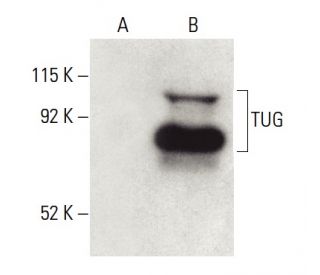


TUG Antibody (4A11A6G11): sc-53952
- TUG Antibody (4A11A6G11) is a mouse monoclonal IgG2b κ TUG antibody provided at 200 µg/ml
- raised against purified truncated recombinant TUG of mouse origin
- TUG Antibody (4A11A6G11) is recommended for detection of TUG of mouse origin by WB, IP, IF and IHC(P)
- Anti-TUG Antibody (4A11A6G11) is available conjugated to agarose for IP; HRP for WB, IHC(P) and ELISA; and to either phycoerythrin or FITC for IF, IHC(P) and FCM
- also available conjugated to Alexa Fluor® 488, Alexa Fluor® 546, Alexa Fluor® 594 or Alexa Fluor® 647 for WB (RGB), IF, IHC(P) and FCM, and for use with RGB fluorescent imaging systems, such as iBright™ FL1000, FluorChem™, Typhoon, Azure and other comparable systems
- also available conjugated to Alexa Fluor® 680 or Alexa Fluor® 790 for WB (NIR), IF and FCM; for use with Near-Infrared (NIR) detection systems, such as LI-COR®Odyssey®, iBright™ FL1000, FluorChem™, Typhoon, Azure and other comparable systems
- m-IgG2b BP-HRP is the preferred secondary detection reagent for TUG Antibody (4A11A6G11) for WB and IHC(P) applications. This reagent is now offered in a bundle with TUG Antibody (4A11A6G11) (see ordering information below).
QUICK LINKS
SEE ALSO...
TUG Antibody (4A11A6G11) is a mouse monoclonal IgG2b kappa light chain antibody that detects TUG protein of mouse origin by western blotting (WB), immunoprecipitation (IP), immunofluorescence (IF), and immunohistochemistry. TUG monoclonal antibody (4A11A6G11) is available in both non-conjugated and various conjugated forms, including agarose, horseradish peroxidase (HRP), phycoerythrin (PE), fluorescein isothiocyanate (FITC), and multiple Alexa Fluor® conjugates. TUG protein, also known as ASPL in humans, plays a critical role in regulating glucose trafficking via glucose transporter Glut4, which is a twelve-pass transmembrane protein. Proper functioning of Glut4 is essential for maintaining glucose homeostasis, and aberrant expression has been linked to metabolic disorders such as obesity and diabetes. Studies on Glut4 null mice indicate that functional Glut4 is not strictly necessary for normal glucose levels, yet remains vital for sustained growth, normal cellular glucose and fat metabolism, and overall longevity. TUG forms a complex with Glut4 in 3T3-L1 adipocytes, which remains intact in unstimulated cells but disassembles upon insulin stimulation. This mechanism allows TUG to trap endocytosed Glut4 and tether intracellularly, with insulin acting to mobilize this retained pool of Glut4 by releasing the tether, thereby facilitating glucose uptake in response to metabolic demands.
Alexa Fluor® is a trademark of Molecular Probes Inc., OR., USA
LI-COR® and Odyssey® are registered trademarks of LI-COR Biosciences
TUG Antibody (4A11A6G11) References:
- Chromosome rearrangement at 17q25 and xp11.2 in alveolar soft-part sarcoma: A case report and review of the literature. | Joyama, S., et al. 1999. Cancer. 86: 1246-50. PMID: 10506710
- The der(17)t(X;17)(p11;q25) of human alveolar soft part sarcoma fuses the TFE3 transcription factor gene to ASPL, a novel gene at 17q25. | Ladanyi, M., et al. 2001. Oncogene. 20: 48-57. PMID: 11244503
- Fusion of a novel gene, RCC17, to the TFE3 gene in t(X;17)(p11.2;q25.3)-bearing papillary renal cell carcinomas. | Heimann, P., et al. 2001. Cancer Res. 61: 4130-5. PMID: 11358836
- Functional cloning of TUG as a regulator of GLUT4 glucose transporter trafficking. | Bogan, JS., et al. 2003. Nature. 425: 727-33. PMID: 14562105
- A TUG on glucose transport. | Saltiel, AR. 2003. Nat Med. 9: 1352. PMID: 14595425
- Solution structure and backbone dynamics of an N-terminal ubiquitin-like domain in the GLUT4-regulating protein, TUG. | Tettamanzi, MC., et al. 2006. Protein Sci. 15: 498-508. PMID: 16501224
- Alveolar soft-part sarcoma of the urinary bladder with urethral recurrence: a unique case with emphasis on differential diagnoses and diagnostic utility of an immunohistochemical panel including TFE3. | Amin, MB., et al. 2006. Am J Surg Pathol. 30: 1322-5. PMID: 17001165
- The glucose transporter 4-regulating protein TUG is essential for highly insulin-responsive glucose uptake in 3T3-L1 adipocytes. | Yu, C., et al. 2007. J Biol Chem. 282: 7710-22. PMID: 17202135
- TFE3 fusions activate MET signaling by transcriptional up-regulation, defining another class of tumors as candidates for therapeutic MET inhibition. | Tsuda, M., et al. 2007. Cancer Res. 67: 919-29. PMID: 17283122
Ordering Information
| Product Name | Catalog # | UNIT | Price | Qty | FAVORITES | |
TUG Antibody (4A11A6G11) | sc-53952 | 200 µg/ml | $316.00 | |||
TUG Antibody (4A11A6G11): m-IgG2b BP-HRP Bundle | sc-548657 | 200 µg Ab; 10 µg BP | $354.00 | |||
TUG Antibody (4A11A6G11) AC | sc-53952 AC | 500 µg/ml, 25% agarose | $416.00 | |||
TUG Antibody (4A11A6G11) HRP | sc-53952 HRP | 200 µg/ml | $316.00 | |||
TUG Antibody (4A11A6G11) FITC | sc-53952 FITC | 200 µg/ml | $330.00 | |||
TUG Antibody (4A11A6G11) PE | sc-53952 PE | 200 µg/ml | $343.00 | |||
TUG Antibody (4A11A6G11) Alexa Fluor® 488 | sc-53952 AF488 | 200 µg/ml | $357.00 | |||
TUG Antibody (4A11A6G11) Alexa Fluor® 546 | sc-53952 AF546 | 200 µg/ml | $357.00 | |||
TUG Antibody (4A11A6G11) Alexa Fluor® 594 | sc-53952 AF594 | 200 µg/ml | $357.00 | |||
TUG Antibody (4A11A6G11) Alexa Fluor® 647 | sc-53952 AF647 | 200 µg/ml | $357.00 | |||
TUG Antibody (4A11A6G11) Alexa Fluor® 680 | sc-53952 AF680 | 200 µg/ml | $357.00 | |||
TUG Antibody (4A11A6G11) Alexa Fluor® 790 | sc-53952 AF790 | 200 µg/ml | $357.00 |
